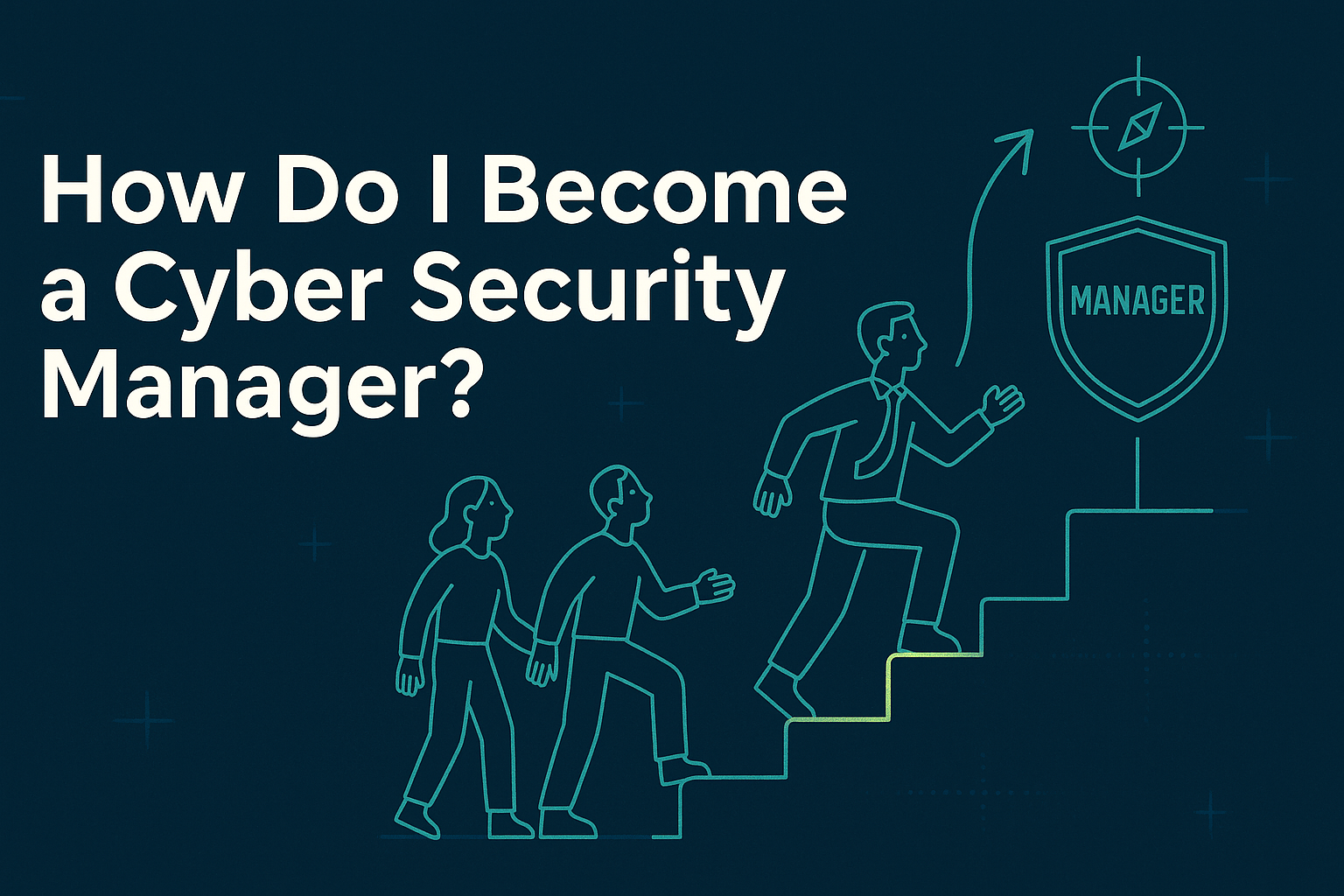How Do I Become a Cyber Security Manager?
Build a leadership-ready skills stack (risk, strategy, people management), run visible security projects that reduce measurable risk, validate with a management-aligned certification (e.g., CISSP or CISM), and assemble a portfolio that proves you can lead a program, not just tickets.
Free resource: Grab The Ultimate Guide to Cyber Security Leadership Certifications and map your fastest path from analyst to leader.
Download the Guide →
What a Cyber Security Manager Actually Does
Managers own outcomes, not just tasks. In most companies, that means:
Risk & strategy: Translate threats into prioritized initiatives tied to business goals.
Program delivery: Run roadmaps (e.g., patch SLAs, phishing reduction, zero-trust rollout).
People leadership: Coach analysts/engineers, set goals, and run 1:1s.
Executive communication: Report KPIs, costs, and residual risk (brief, visual, story-driven).
Governance & vendors: Policies, exceptions, audits, and contract/value management.
If you can consistently show “risk down, friction down, value up,” you’re acting like a manager already.
The Manager Skills Map (and how to acquire each)
Risk & governance ->Risk registers, control selection, policy lifecycle, third-party risk -> A short risk assessment + treatment plan; a policy update with approvals
Program & project delivery ->Roadmaps, budgets, OKRs/KPIs, cross-team dependencies -> A 90-day plan, RAID log, before/after metrics
Technical breadth ->Cloud security, identity, vulnerability mgmt, incident response -> Architecture review doc, updated runbooks, reduced MTTR
People leadership ->Coaching, feedback, interviewing, delegation -> Growth plans for two teammates; hiring rubric
Executive communication -> Business cases, dashboards, board-safe language -> One-page exec memo; monthly KPI deck
Vendor & financials ->RFPs, renewals, total cost, service levels -> Negotiation summary saving $$ or adding capabilities
12-Month Action Plan (while you’re still in your current role)
Months 0–1: Assess & aim
Pick a target role title (e.g., Security Operations Manager, GRC Manager, BISO).
Gap-analysis: compare 10 job posts; list repeated requirements.
Book recurring 1:1 with your manager to align on a stretch project that benefits the team.
Months 2–4: Deliver a visible win
Choose a project with clear, measurable impact, such as:
Cut critical vulns >30 days by 50%.
Reduce phish click-rate below 2%.
Roll out MFA coverage to 99% with a friendly UX plan.
Publish a brief plan, owners, dates, and KPIs. Share progress weekly.
Months 5–6: Validate with a certification (optional but powerful)
If you’re engineering/ops-leaning → CISSP; if governance-leaning → CISM.
If your org is mid-migration → add CCSP next.
Build a 6-week study cadence and book the exam date now (deadlines drive progress).
Months 7–9: Prove leadership beyond tech
Mentor two teammates: pair on investigations or risk reviews.
Build a one-page exec brief template: risk, cost, timeline, decision needed.
Own a vendor renewal: document ROI, negotiate terms, and write the decision memo.
Months 10–12: Package your evidence & apply
Assemble a Leadership Evidence Pack (scrubbed of sensitive data):
Program charter, KPI dashboard, risk treatment plan, incident post-mortem, policy update, vendor ROI memo.
Update résumé & LinkedIn to manager verbs: led, owned, prioritized, negotiated, improved by X%.
Get two references (one technical, one business partner).
Portfolio Pieces Hiring Managers Love
Before/after metrics chart with a one-paragraph story.
Risk acceptance memo demonstrating business alignment.
Architecture decision record (ADR) for a control choice (e.g., CASB vs native).
Training plan that lowered an error/incident rate.
Runbook that shaved minutes from detection or response.
Common Mistakes That Stall Promotions
Talking in tools, not outcomes. Switch “we deployed X” to “we reduced Y risk/cost/time.”
No artifacts. If you didn’t write it down, it didn’t happen.
Going it alone. Managers win by coalition, not heroics. Bring Finance, Legal, HR, and IT along.
Chasing every cert. One leadership-aligned cert + a cloud add-on usually beats five niche badges.
Interview Prep: Manager-Level Answers
Use STAR (Situation, Task, Action, Result) but add Business Impact at the end.
Prompt: “Tell me about improving a security metric.”
Answer skeleton: Situation → Goal (threshold/target) → Options considered → Action taken → Result (% improvement + dollars/time saved) → Business impact (less downtime, faster onboarding, audit pass).
Call to Action: Lock in Your Certification Plan
Becoming a manager is faster when your résumé passes filters and your skills match the seat.
Download “The Ultimate Guide to Cyber Security Leadership Certifications” and get a printable matrix of leadership-aligned certs, study timelines, and selection criteria for free.
Frequently Asked Questions
Do I need a certification to become a manager?
Not strictly, but a leadership-aligned cert (CISSP or CISM) gets you past HR filters and signals readiness to executives.
How many years of experience do I need?
Typically 4–7 years of relevant security experience. Evidence of leading projects and influencing stakeholders can shorten that timeline.
Is a degree required?
Many managers have degrees, but strong experience + results + a recognized certification often substitutes.
I’m in help desk/IT. How do I pivot?
Volunteer for security-adjacent work (identity, patching, hardening), run a small project with metrics, then move to an analyst role en route to management.
Next Step
You’ve got this. Pick one project, one certification, one leadership behavior to practice this week and start compiling your Leadership Evidence Pack. Your manager role will follow.
Bookmark this post, share it with your team, and, most importantly, download the guide so you can take action on the path that propels you from practitioner to cyber security leader.


